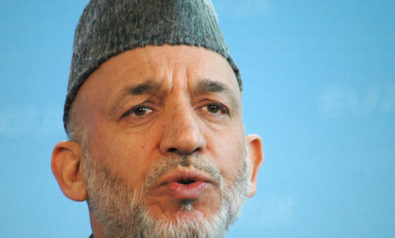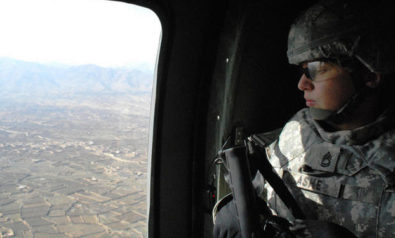Islamabad’s “strategic depth” policy suggests turning Afghanistan into a client state that is beholden to Pakistan.
As Afghanistan gears up for the second round of its presidential election, one can confidently put forward two assessments. First, this political transition — the first democratic transfer of power in Afghanistan — is more crucial for purposes of state legitimacy for most Afghans than anything else. Second, amid the drawdown of military and civilian engagement in the country, the relationship between Kabul and Islamabad is increasingly salient to the future of Afghanistan.
As Afghanistan gears up for the second round of its of Pakistan’s relationship with Afghanistan and the origins of the oft-cited rationale for Islamabad’s quest of “strategic depth” in the country, as well as the implications for its future.
A Brief History of Afghanistan-Pakistan Relations
When Sir Mortimer Durand, foreign secretary of British India, drew a 2,640 kilometer line between Afghanistan and British India in 1893, his aim was to create a buffer state between imperial Britain’s territory and Czarist Russia. The border, popularly referred to as the Durand Line, was established after an agreement was forged between Durand and the Emir of Afghanistan, Abdur Rahman Khan, to fix the limit of their respective spheres of influence. The deal sanctified Britain’s control over its Pashtun possessions by dividing Pashtun tribal areas and the Balochistan region. In the process, the Durand Line politically divided ethnic Pashtuns and Baloch who lived on both sides of the border.
Although recognized internationally as the western border of Pakistan, the Durand Line is disputed by Afghanistan as a “geopolitical myth” since it divides the Pashtuns. It is on these grounds that Afghanistan, an independent state for longer than Pakistan, opposed the latter’s creation and entry into the United Nations. However, Afghanistan’s relative small size, lack of access to the sea, and absence of geopolitical clout denied it the means to force a redrawing of the border.
While Afghanistan has sought to reintegrate the Pashtuns, Pakistan has come up with various arguments to justify a “fusion” of the two states. Pakistan argues that the Durand Line is a settled matter and Afghan reluctance to accept the border is the cause of many problems between the two states. Pakistani strategists often quote British historian Fraser Tytler who wrote, shortly after Pakistan was created, that: “History suggests that fusion will take place, if not peacefully, then by force.”
The Doctrine of Strategic Depth in Afghanistan
Several methods have been used to force this fusion. The first attempt saw a suggestion to create an Afghanistan-Pakistan federation. In the 1950s, Ayub Khan, Pakistan’s first military ruler, argued for a federation of the two states based on religion. He later expanded the argument, calling for a grand confederation of like-minded and territorially contiguous Muslim countries, including Afghanistan, Pakistan, Iran and Turkey. Khan’s argument was that such a confederation would help Pakistan stand up to India, as it would provide resources and strength in numbers to match its larger foe. Later, during the Soviet Union’s (USSR) intervention in Afghanistan, the Pakistani military’s support for the mujahideen was justified as seeking to prevent encirclement by India and a Soviet-backed Afghanistan.
The Pakistani military doctrine behind the concept of strategic depth suggests transforming Afghanistan into a client or subservient state that is beholden to the Pakistani security establishment.
The case that has been most often argued, especially since the late 1980s, is the Pakistani need for “strategic depth” in Afghanistan. In military terms, this broadly refers to the distances between the front lines and a country’s industrial nucleus, population centers, heartlands and locations of its military industry. The argument that underscores this concept is that a military commander must consider the vulnerability of its assets to an offensive, and consider whether it can withdraw into its own territory, absorb an initial thrust and regroup. Strategic depth is thus, essentially, a trade-off between space and time.
The concept was said to have been first articulated in the 1980s. It then became a policy to be pursued in order to respond to a potential military strike by India. Since then, the Pakistani military establishment has used this policy to justify manipulating the politics of Afghanistan, by using violence and terror as state instruments of control. In pursuit of this strategic depth, the military exploited the material-needs and nationalistic fervor of specific mujahideen leaders who sought support to fight the USSR,religious extremist groups and, more recently, the Taliban, in a bid to subdue, marginalize and decapitate the Afghan state.
After Pakistan went nuclear, the raison d’être of strategic depth diminished in relevance. The concept was reworked and, in early 2010, Gen. Ashfaq Parvez Kayani argued that Pakistan wanted “strategic depth in Afghanistan but [did] not want to control it.” He added that a “peaceful, friendly and stable” relationship with Afghanistan would ensure that Pakistan is not threatened with security problems on its western border. Kayani went further and asserted that Afghan state institutions, including the army and police, should be kept in check so they do not pose a threat to Pakistan’s “strategic interests.”
The Challenges
There are several inherent challenges in the concept of strategic depth. First, it seems militarily bankrupt since it implies that, in the event of an attack from India, the Pakistani army would retreat to Afghanistan — a near impossible feat — to regroup and launch a counterattack. The concept accords little consideration, if any, to the fate of the 180 million Pakistani civilians that the military would leave behind, a politically impossible feat, to pursue this “depth.”
Second, what makes the concept unfeasible is the fact that Afghanistan has not diluted its claims to the Pashtun parts of Pakistan. No Afghan leader has accepted the Durand Line. It has been argued that even the Taliban, beholden to Pakistan for its very existence, could not do so.
However, there is an equally compelling argument that Afghan claims over the Pashtuns actually works to Pakistan’s advantage, as it gives them a rationale to continue meddling in Afghan affairs. Article 2 in the Durand Line agreement was, in fact, formulated to prevent this: “The Government of India [Pakistan] will at no time exercise interference in the territories lying beyond this line on the side of Afghanistan.” However, it should be noted that Pakistan’s record of adherence to bilateral agreements has been anything but consistent.
Implications for Afghanistan
The Pakistani military doctrine behind the concept of strategic depth suggests transforming Afghanistan into a client or subservient state that is beholden to the Pakistani security establishment. Unchallenged pursuit of this policy could potentially widen the area of military conflict and drag Afghanistan into the Indo-Pak equation.
With the West increasingly wary of committing any further forces to Afghanistan, Pakistan seems to have won at least partial acceptance of its argument (to the West) that stabilizing Afghanistan is not possible without addressing Islamabad’s concerns. Senior US officials have privately argued that Pakistan, its nukes, and the public face of extremism permeating its society are a collective global challenge. Afghanistan is merely a “side show” when compared to the concern that Pakistan poses for the US and the West.
Questions to Ponder
Western and Pakistani narratives suggest the proxy war is a new variant of the Great Game, now being fought between India and Pakistan. However, the question that one should ask is this: Do Pakistan’s policies in Afghanistan constitute a barely disguised land grab or are they an extension of the Great Game? Added to this, can the policies that originate from Pakistan’s imagined fear of encirclement by India be pursued at the cost of sovereignty of an independent nation? And is Pakistan simply seeking to splinter Afghanistan on ethnic lines and, in the process, enlarge its size, secure its elusive “strategic depth” and quell Pashtun nationalism?
The sooner policymakers in Delhi examine these issues, the more likely they will be to prioritizing their approach to post-2014 Afghanistan.
The views expressed in this article are the author’s own and do not necessarily reflect Fair Observer’s editorial policy.
Support Fair Observer
We rely on your support for our independence, diversity and quality.
For more than 10 years, Fair Observer has been free, fair and independent. No billionaire owns us, no advertisers control us. We are a reader-supported nonprofit. Unlike many other publications, we keep our content free for readers regardless of where they live or whether they can afford to pay. We have no paywalls and no ads.
In the post-truth era of fake news, echo chambers and filter bubbles, we publish a plurality of perspectives from around the world. Anyone can publish with us, but everyone goes through a rigorous editorial process. So, you get fact-checked, well-reasoned content instead of noise.
We publish 2,500+ voices from 90+ countries. We also conduct education and training programs
on subjects ranging from digital media and journalism to writing and critical thinking. This
doesn’t come cheap. Servers, editors, trainers and web developers cost
money.
Please consider supporting us on a regular basis as a recurring donor or a
sustaining member.
Will you support FO’s journalism?
We rely on your support for our independence, diversity and quality.









Comment
The writing is nice, but there are some points need to be considered.
1. Pakistan is heavily dependent on western aid and support.
2. Pakistan is the shadow of British in the region and follows the same policy of divide and rule.
3. FATA was never controlled by Pakistan before western entry to the region and all of a sudden it’s military moved forward in FATA area.
4. Cold war was between US and USSR, played the puppet role assigned to it by Western power.
5. Jihad was a mire play that Afghan idiots whom was ready to do anything for personal gain and using Islam as tool
6. Saudi Arabia made fool by Western power and Pakistan to provide fund which is continuing until date
7. India is too big and militarily giant to be defeated by Pakistan and India proved it’s supremacy in last four wars with unmatched power, country size and huge population
Pakistan is resources scarce country, had and has only option to follow western polity in the region
@Aryan you are completely right.